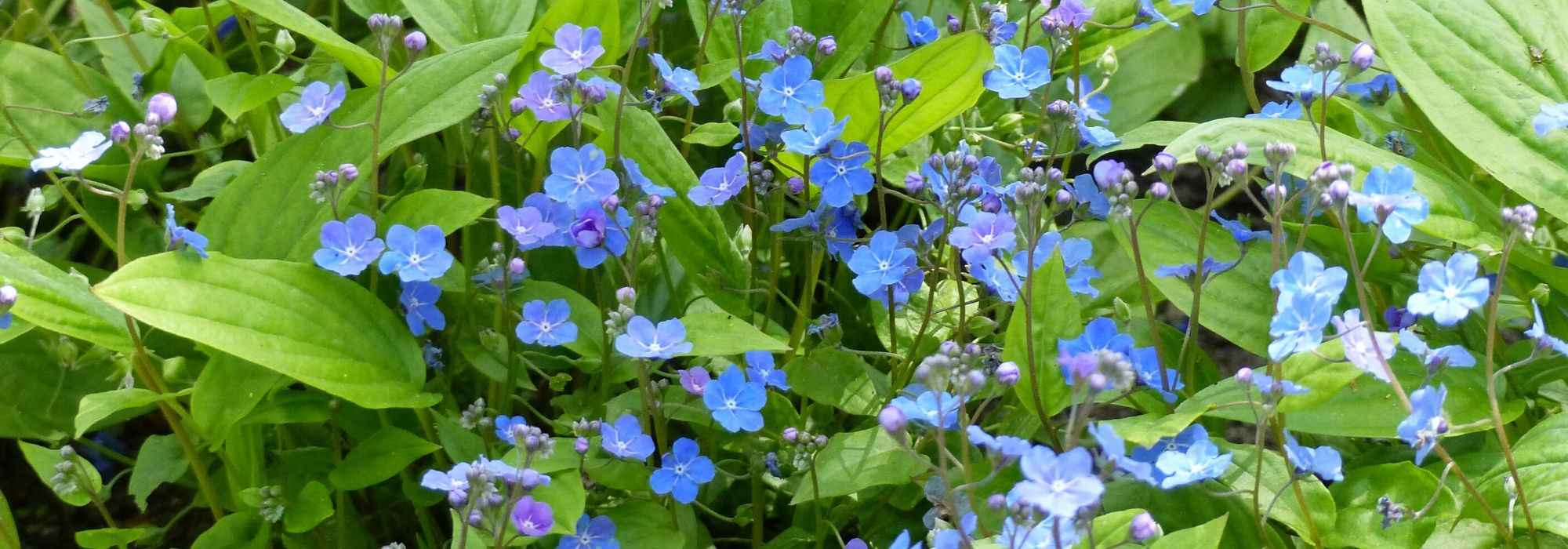
Omphalodes: planting, cultivation, and care
Contents
Omphalodes in a nutshell
- Omphalodes is a small perennial groundcover for light shade
- Its spring flowering, white or blue, is of great delicacy
- A lover of woodlands and edges, it is a rather slow-growing perennial but very accommodating regarding soil type
- Hardy and easy to maintain, it gradually spreads to form dense carpets
- Its green to blue-green foliage can be deciduous to evergreen
- Resistant to diseases, it is sometimes favoured by slugs
The word from our expert
Omphalodes is one of those perennial groundcovers that captivates us with its delicacy and beauty. A close relative of Myosotis, it thrives at the edges of shaded borders when, between March and May, its charming little flowers bloom in abundance. Their colours, blue in varying shades, as well as white or bicoloured, bring depth and brightness to the garden.
A hardy and robust perennial, it is low-maintenance and finds its place in light soil as well as in heavier terrains, whether acidic or calcareous. With a rather slow growth rate, it spreads over the years through its creeping stems that root into the soil.
Also known as ‘Small Borage’ or ‘Navelwort’, this low-growing perennial (about 20 cm) requires very little maintenance and is resistant to diseases. Only slugs may take an interest in its foliage, which can be deciduous or evergreen depending on the species and the severity of winter.
When paired with spring-flowering bulbs, certain perennials, and grasses, it allows for the creation of colourful and fresh borders from the first sunny days of spring.
Description and Botany
Botanical data
- Latin name Omphalodes
- Family Boraginaceae
- Common name Bluebell, Venus's Navel
- Flowering Spring (March to May)
- Height 15 to 25 cm X 20 to 40 cm
- Exposure dappled shade, filtered light
- Soil type any type of soil
- Hardiness good (-15°C)
The Omphalodes is a small herbaceous groundcover plant from the Boraginaceae family, alongside forget-me-nots, borage, and comfrey. Its distribution range is vast, and it can be found from Europe to Asia, including Mexico and North Africa. It primarily thrives in wooded, montane areas or certain coastal regions. Its name, derived from the Ancient Greek ‘Omphalos’, meaning ‘navel’, refers to the small orifice present on each seed. This plant is sometimes referred to as ‘Venus’s Navel‘ (which is also the case for another perennial of a completely different genus, Umbilicus rupestris) or ‘Bluebell’. Among the thirty species of annuals, biennials, or perennials recorded, it is mainly Omphalodes cappadocica and Omphalodes verna that are cultivated in our gardens. Omphalodes linifolia is an annual that prefers light, well-drained soils in the sunny and arid regions of Southwestern Europe. Omphalodes commutata behaves as an annual or biennial in rocky or calcareous areas. The perennial species in our gardens prefer fresher and shadier environments.
Excellent groundcovers, these small perennials feature foliage that can be deciduous, semi-evergreen, or evergreen depending on the species and growing conditions. The leaves are simple, measuring 5 to 15 cm long, and are arranged alternately or oppositely on the stems. More or less oval, lanceolate, or heart-shaped, some display prominent veins. They can be glabrous or slightly pubescent. They form a compact basal tuft, bright green and vibrant, sometimes slightly bluish and with a crinkled appearance.
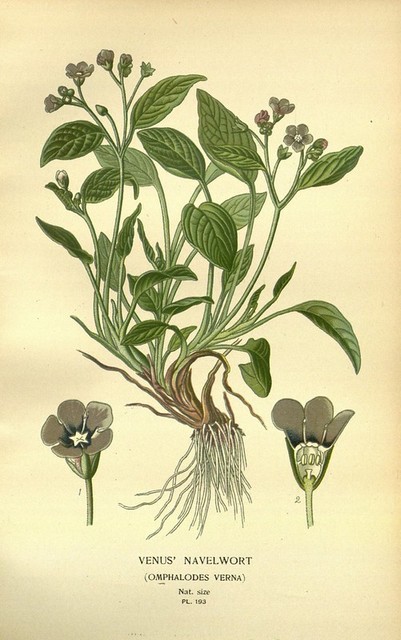
Omphalodes verna – botanical illustration
Their small dimensions, around 15 to 25 cm high with a spread of 20 to 40 cm, allow them to be integrated into any type of garden, including those of modest size. Omphalodes also perform very well in pots, allowing you to enjoy them on a balcony or terrace.
These spreading perennials are highly valued for their delicate flowering, which occurs in spring, typically between March and May. The flowers, measuring from a few millimetres to 1.5 cm, are grouped in light, airy clusters at the tips of the stems, supported by long pedicels, about twenty centimetres long, with a soft, trailing habit. Each flower consists of 5 petals arranged in a star shape. The inflorescences can be deep blue or lilac, highlighted by a white centre, or entirely white. Omphalodes cappadocica ‘Starry Eyes’ offers a delicate pale blue edged with white.
The flowers give rise to nutlets, which are a type of achene with a very hard wall (similar to acorns or hazelnuts).
The growth rate of Omphalodes varies, depending not only on the species and variety but also on the soil in which they grow. Equipped with stolons that run along the ground and root, the plant gradually spreads to form beautiful carpets, without becoming invasive.
An excellent groundcover for dappled shade, Omphalodes is a perennial that is easy to grow and maintain. Hardy down to -15°C, it is not affected by diseases. Beware of slugs and snails, which enjoy its foliage.
Read also
10 plants to create a shady rockeryThe different varieties of Omphalodes
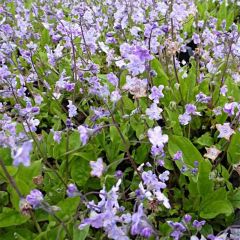
Omphalodes cappadocica Lilac Mist
- Flowering time May, June
- Height at maturity 25 cm
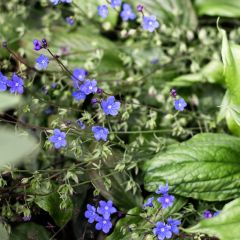
Omphalodes cappadocica Cherry Ingram
- Flowering time May, June
- Height at maturity 25 cm
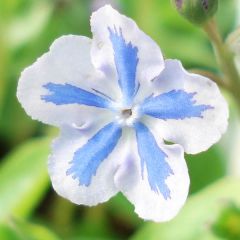
Omphalodes cappadocica Starry Eyes
- Flowering time May, June
- Height at maturity 25 cm
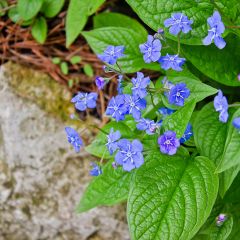
Omphalodes verna
- Flowering time April to June
- Height at maturity 30 cm
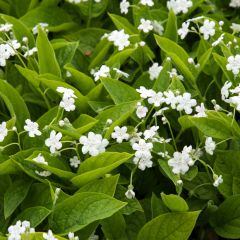
Omphalodes verna Alba
- Flowering time April to June
- Height at maturity 20 cm
Discover other Omphalode
View all →Available in 0 sizes
Available in 1 sizes
Available in 1 sizes
Available in 1 sizes
Available in 1 sizes
Available in 1 sizes
Available in 1 sizes
Planting Omphalodes
Where to plant?
The “Small Borage” are perennial plants for light shade or dappled light. Plant them under the cover of deciduous trees or bushes with light foliage. Their small size makes them suitable for bordering flower beds and woodland edges, and they also integrate very well into cool rockeries. They are not deterred by heavy clay soils, nor by drier, chalky ones. Once established, Omphalodes can withstand occasional droughts. In cool, humus-bearing, light soil, Omphalodes verna, the botanical species, spreads easily through its stolons that root upon contact with the soil. The white-flowered cultivar ‘Alba‘ is slightly less vigorous. In drier soil, Omphalodes cappadocica performs very well and occupies less space.
Feel free to grow “Venus’s Navel” in a pot to enjoy its beautiful flowering on a terrace or balcony that is not too hot.
When to plant?
As with many perennials, planting ideally takes place in autumn or spring.
How to plant?
Planting in the ground
- Soak the root ball or pot in a bucket of water for about ten minutes
- In the meantime, dig a hole that is 2 to 3 times the size of the root ball in all directions and loosen the soil well.
- Mix one or two large handfuls of light potting soil or homemade compost with the extracted soil.
- Place the plant in its location, ensuring the top of the root ball is level with the soil.
- Fill in with the remaining mix and lightly firm with your fist.
- Water generously, even in damp weather, to ensure the soil adheres well to the roots.
- Mulch with fallen leaves, RCW, or dried grass clippings to keep the base cool and limit competition from weeds.
Planting in a pot
- Soak the root ball for a few minutes in a bucket of water
- Choose a pot at least 30 cm in all dimensions, with a drainage hole
- Prepare a mix of garden soil and potting soil, adding a handful of compost
- Pour your mix into the pot and place your plant so that the surface of the root ball is 3 to 4 cm from the top of the container
- Fill in with the remaining mix and lightly firm
- Water to moisten the entire substrate
- Mulch on the remaining thickness
- Keep the potting soil always moist but not waterlogged
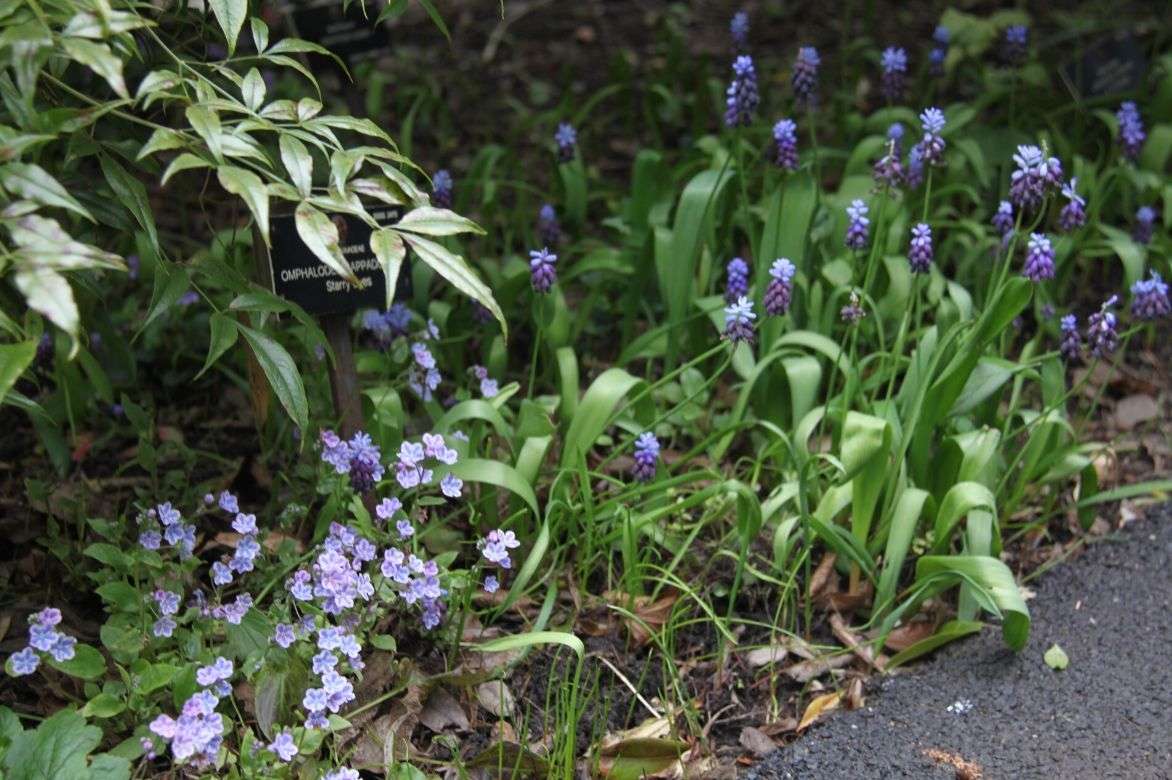
Omphalodes ‘Cappadocica ‘Starry Eyes’ alongside Muscari latifolium
Care and Maintenance of Omphalodes
Omphalodes are plants that require very little care. A single cleaning of the old foliage at the beginning of spring is sufficient.
In case of slug presence, use a natural method to anticipate the risk of attacks.
Multiplying Omphalodes
Although root propagation is possible, the simplest method to multiply Omphalodes is by division of the stump, to be carried out in autumn or spring. Only intervene on well-established and sufficiently developed plants, as this is a perennial that may take some time to show its best.
- Ideally, water the plant to be multiplied the day before the operation.
- Clear the mulch around the plant to be divided, then, using a sharp spade, slice a piece from the periphery, ensuring there are enough roots.
- Gently remove the clump thus obtained and replant it in its final location.
- Don’t forget to fill the gap left on the mother plant with soil from your garden, incorporating a bit of compost.
- Water and mulch.
- Monitor watering in the first few weeks, especially if you divide the plant in spring and the weather is dry.
Associate the Omphalodes
Perennial groundcover for light shade, Omphalodes pairs beautifully with spring-flowering bulbs, such as daffodils or tulips. The white colour of the ‘Alba’ variety tempers the bold hues of companion plants. Other varieties, with blue tones, look stunning alongside warmer colours like yellow or orange. Tulips ‘Orange Emperor’ or ‘Happy People’, as well as daffodils ‘Tête à tête’ or ‘Yellow Cheerfulness’, allow you to create beautiful combinations. In terms of perennials, the pairing with wood anemones or Bleeding Hearts works very well. Complete the display with Heucherella or with the lightness of a Hakonechloa, whose young foliage beautifully complements spring blooms. The use of ferns further enhances the woodland atmosphere.
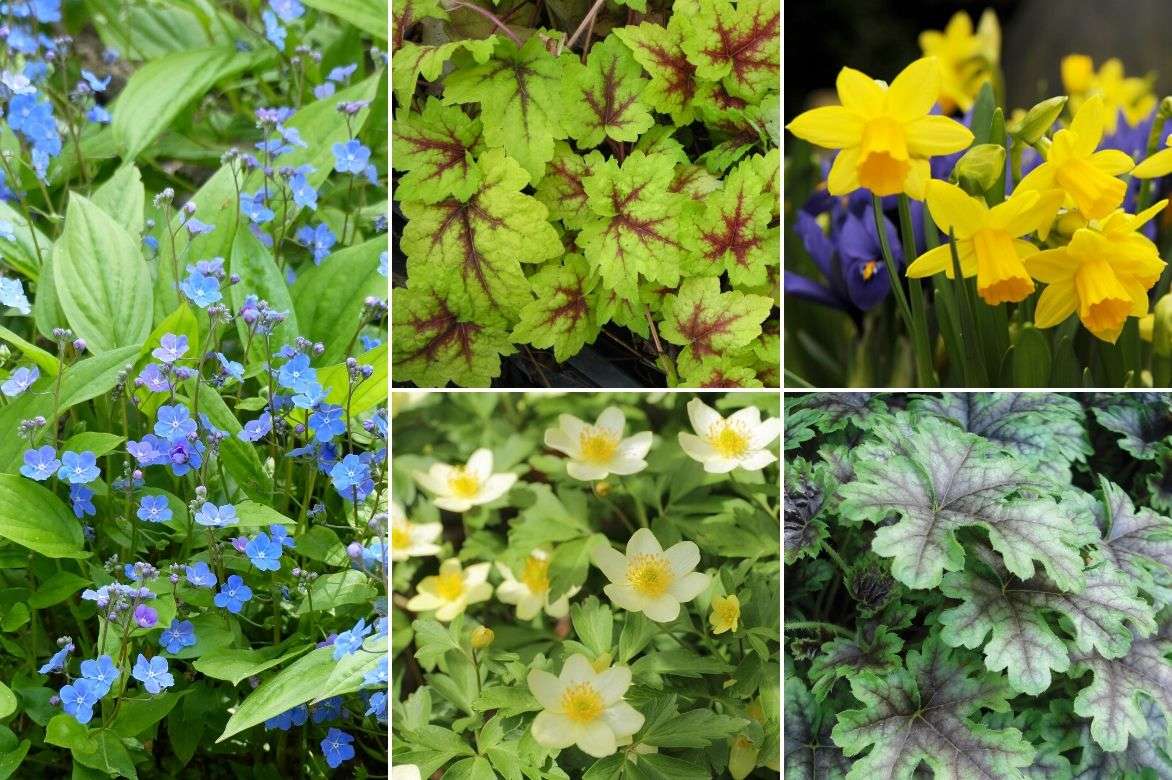
An example of a woodland association: Omphalodes cappadocica (‘Cherry Ingram’ for example), Heucherella ‘Stoplight’, Daffodils ‘Tête à tête’, Anemone lipsiensis and Heucherella ‘Tapestry’, add some ferns Dryopteris erythrosora or Polystichum setiferum ‘Proliferum’
Useful resources
- Find all our varieties of Omphalodes in our online nursery.
- Discover Myosotis and Brunnera, two other beautiful groundcover plants with a similar appearance.
- Planning a shady border? Get inspired by our guides on shade perennials and the bushes that can accompany them.
- Enhance the foreground of your borders with our selection of perennials for borders.
- Subscribe!
- Contents
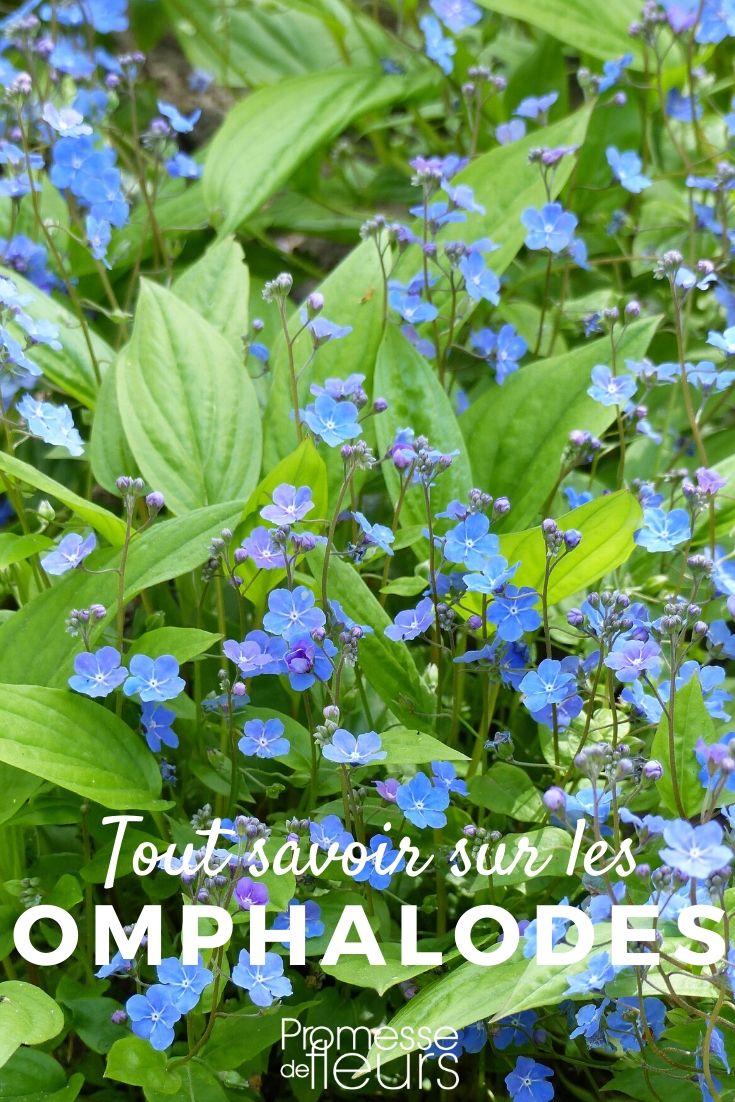































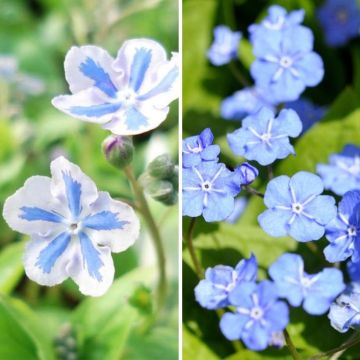




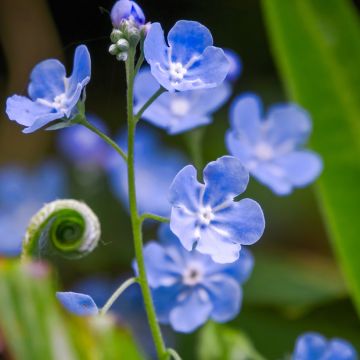

Comments